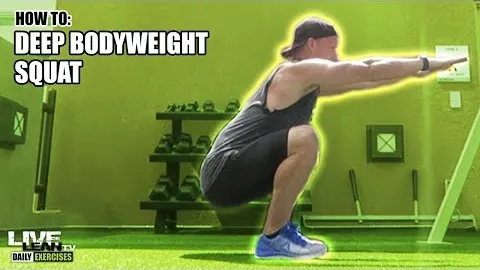
In the world of fitness, the deep squat exercise is renowned for its ability to strengthen and mobilize the entire body. This compound movement engages multiple muscle groups, including the quadriceps, hamstrings, glutes, calves, core, and even the upper body to some extent. Incorporating the deep squat into your workout routine can lead to significant improvements in strength, flexibility, balance, and overall functional performance. In this article, we will explore the numerous benefits of the deep squat exercise and provide tips for proper form and progression.
Perhaps the most obvious benefit of the deep squat exercise is its ability to build strength in the legs and glutes. As you lower yourself into a deep squat, your quadriceps, hamstrings, and glutes are activated to drive the movement. These muscles are essential for everyday activities such as walking, running, climbing stairs, and lifting objects. By incorporating deep squats into your training regimen, you will develop powerful and resilient lower body muscles that can enhance your overall athletic performance.
Another key benefit of the deep squat exercise is its positive effect on hip and ankle mobility. When performed correctly, deep squats involve a full range of motion in these joints, helping to improve flexibility and enhance joint stability. This increased mobility can translate into improved performance in activities that require hip and ankle flexibility, such as sports, dance, and martial arts. Moreover, maintaining good hip and ankle mobility can help prevent injuries, as it allows for proper alignment and reduces the risk of strain on surrounding muscles and ligaments.
The deep squat exercise is not only a lower body movement; it also engages the core muscles, including the abdominals, obliques, and lower back. Your core acts as a stabilizer during the squat, helping to maintain proper posture and balance throughout the movement. By regularly performing deep squats, you can strengthen your core muscles, improving overall stability and reducing the risk of back pain or injury. The engagement of the core muscles during deep squats also promotes better posture, which can have a positive impact on your everyday life.
Functional fitness refers to the ability to perform daily activities with ease and efficiency. Deep squats are a functional exercise as they mimic the movements required for everyday tasks such as lifting heavy objects, bending down, or getting up from a seated position. By regularly practicing deep squats, you can develop the strength, mobility, and stability necessary to perform these duties without strain or discomfort. Whether you are an athlete looking to improve performance or an individual seeking to enhance overall functional fitness, incorporating deep squats into your routine is an excellent choice.
Deep squats are a compound movement that engages multiple muscle groups simultaneously, resulting in a high energy expenditure. As a result, incorporating deep squats into your workout routine can contribute to burning a significant number of calories, which can aid in weight loss and body fat reduction. Additionally, the increased muscle mass developed through regular deep squat training can lead to a higher metabolic rate, allowing you to burn more calories even at rest. To optimize calorie burning, consider adding deep squats to a high-intensity interval training (HIIT) routine.
To perform a deep squat correctly, follow these steps:
As with any exercise, it is essential to start with proper form and progress gradually to avoid injury. If you are new to deep squats, begin by practicing bodyweight squats and gradually increase the depth and resistance as you gain strength. Alternatively, you can use a stability ball or a TRX suspension trainer to assist with balance and control.
In conclusion, the deep squat exercise offers a wide range of benefits for total body strength and mobility. By incorporating deep squats into your workout routine, you can build strong legs and glutes, improve hip and ankle mobility, enhance core strength and stability, boost functional fitness, burn calories, and aid in weight loss. Remember to always prioritize proper form and progression to maximize the benefits of this powerful exercise. So why wait? Start incorporating deep squats into your fitness routine and reap the rewards for your body and overall well-being.
If you're looking for a gym, fitness club or yoga studio, you've come to the right place.
You can find information about gyms in your area. Browse catalog of gyms and find gyms with classes which are you looking for.
On gym page you can find simple information like address, phone or website. You can find list of available classes. You can check availability of personal training or small group classes. On place page you can also see information about open hours.
You can find gyms near you with amenities, courts, studios and equipments.
Use our map to find gym at your city or district.
In Gym Navigator you can find list of exercises with movies for many body parts.
You can browse exercises catalog and find exercises the best of you.
You can also find exercises grouped into workout plans, which you can use to improve you body. Each routine show you exercises one by one and give you possibility to count you progress and count down rest time.